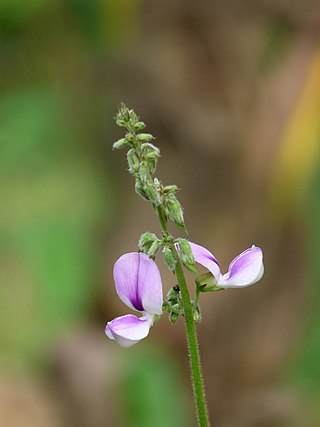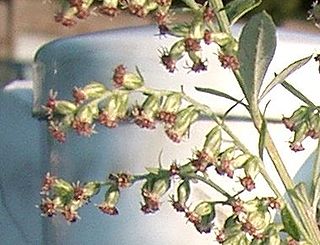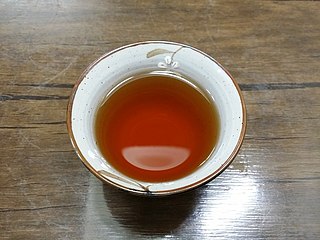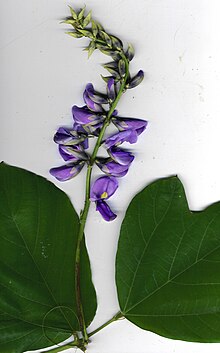
Kudzu, also called Japanese arrowroot or Chinese arrowroot, is a group of climbing, coiling, and trailing deciduous perennial vines native to much of East Asia, Southeast Asia, and some Pacific islands, but invasive in many parts of the world, primarily North America.

Pueraria montana is a species of plant in the botanical family Fabaceae. At least three sub-species are known. It is closely related to other species in the genus Pueraria and the common name kudzu is used for all of these species and hybrids between them. The morphological differences between them are subtle, they can breed with each other, and it appears that introduced kudzu populations in the United States have ancestry from more than one of the species.
The Kuzu (国栖・国巣・国樔) were a people of ancient Japan believed to have lived along the Yoshino River in Nara Prefecture. They were mentioned in the Kojiki and Nihon Shoki. The name was also used for a population living in the old Hitachi province mentioned by the Hitachi Fudoki.

Pueraria is a genus of 15–20 species of legumes native to south, east, and southeast Asia and to New Guinea and northern Australia. The best known member is kudzu, also called Japanese arrowroot. The genus is named after 19th century Swiss botanist Marc Nicolas Puerari.

Senna obtusifolia, known by the common names Chinese senna, American sicklepod, sicklepod, etc., is a plant in the genus Senna, sometimes separated in the monotypic genus Diallobus. It grows wild in North, Central, and South America, Asia, Africa, and Oceania, and is considered a particularly serious weed in many places. It has a long-standing history of confusion with Senna tora and that taxon in many sources actually refers to the present species.

Daidzein is a naturally occurring compound found exclusively in soybeans and other legumes and structurally belongs to a class of compounds known as isoflavones. Daidzein and other isoflavones are produced in plants through the phenylpropanoid pathway of secondary metabolism and are used as signal carriers, and defense responses to pathogenic attacks. In humans, recent research has shown the viability of using daidzein in medicine for menopausal relief, osteoporosis, blood cholesterol, and lowering the risk of some hormone-related cancers, and heart disease. Despite the known health benefits, the use of both puerarin and daidzein is limited by their poor bioavailability and low water solubility.

Manjū is a traditional Japanese confection. Of the many varieties of manjū, most have an outside made from flour, rice powder, kudzu, and buckwheat, and a filling of anko, usually made from boiled adzuki beans and sugar. Manjū is sometimes made with other fillings such as chestnut jam. In Hawaii, one can find Okinawan manjū that are made with a filling of purple sweet potato, butter, milk, sugar, and salt, but the most common filling is bean paste, of which the several varieties include koshian, tsubuan, and tsubushian.

Zanthoxylum ailanthoides, also called ailanthus-like prickly ash, is an Asiatic plant of the prickly-ash genus Zanthoxylum, natively occurring in forest-covered parts of southeastern China, Taiwan, Southeast Asia, and Japan from Honshu southward. The piquant fruit serves as a local substitute for the ordinary red-pepper in China before the Columbian exchange. In Taiwan, the young leaves are used in cuisines.

Artemisia princeps, also commonly called yomogi, Japanese mugwort, Korean wormwood, Korean mugwort or wormwood in English, is an Asian plant species in the sunflower family, native to China, Japan and Korea. It is a perennial, very vigorous plant that grows to 1.2 meters. This species spreads rapidly by means of underground stolons and can become invasive. It bears small, buff-colored flowers from July to November which are hermaphroditic, and pollinated by wind. The leaves are feather shaped, scalloped and light green, with white dense fuzz on the underside.
The Kuzu were a people of ancient Japan.

Arrowroot tea, also called kudzu tea, is a traditional East Asian tea made from East Asian arrowroot, a type of kudzu.

Kudzu powder, called géfěn (葛粉) in Chinese, kuzuko in Japanese, chik-garu (칡가루) or galbun in Korean, and bột sắn dây in Vietnamese is a starch powder made from the root of the kudzu plant. It is used in traditional East Asian cuisine mainly for thickening sauces and making various types of desserts.

Kudzu is an invasive plant species in the United States, introduced from Asia with devastating environmental consequences, earning it the nickname "the vine that ate the South". It has been spreading rapidly in the Southern United States, "easily outpacing the use of herbicide, spraying, and mowing, as well increasing the costs of these controls by $6 million annually". Estimates of the vine's spread vary, from the United States Forest Service's 2015 estimate of 2,500 acres per year to the Department of Agriculture's estimate of as much as 150,000 acres annually.

Dioscorea japonica, known as East Asian mountain yam, yamaimo, or Japanese mountain yam, is a type of yam (Dioscorea) native to Japan, Korea, China, Taiwan, and Assam.
Arrowroot is a starch obtained from the rhizomes (rootstock) of several tropical plants, traditionally Maranta arundinacea, but also Florida arrowroot from Zamia integrifolia, and tapioca from cassava, which is often labeled arrowroot. Polynesian arrowroot or pia, and Japanese arrowroot, also called kudzu, are used in similar ways. In India, it is called palua.
Arrowroot is to an edible starch obtained from several tropical plants.

Neustanthus is a monotypic genus of flowering plants belonging to the pea family Fabaceae and its tribe Phaseoleae. The only species is Neustanthus phaseoloides, called tropical kudzu. This species is a forage crop and cover crop used in the tropics. It is known as puero in Australia and tropical kudzu in most tropical regions.
Devosia yakushimensis is a Gram-negative, obligately aerobic, motile bacteria from the genus of Devosia with a polar flagellum which was isolated from the plant Pueraria montana var. lobata in Japan.

Gyeolmyeongja-cha or sicklepod tea is a tea made from roasted seeds of Senna spp., especially S. obtusifolia and S. tora.
Phaseolus trilobus can refer to:
















